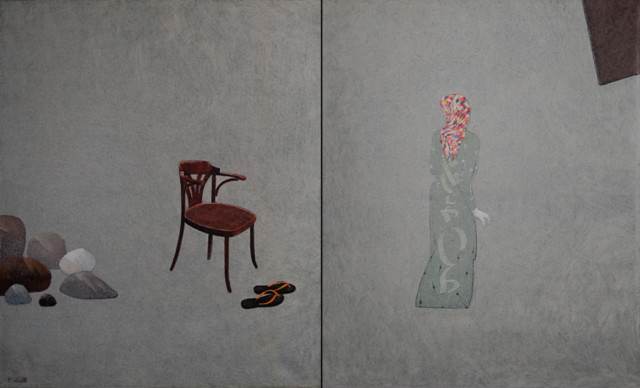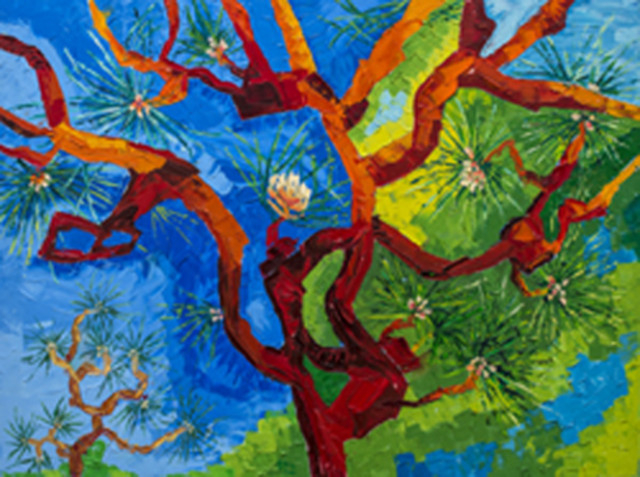
Iranian artist Rezvan Sadeghzadeh’s latest exhibition, “Passing the Crisis”, features a series of paintings depicting chador-clad women confronted by huge obstacles in the form of stones. Rather than fighting these obstacles or reacting to them in any way, the women calmly and helplessly watch them. These poignant paintings comment on the situation of women in a male-dominated society. But they are also about the human condition in general. “In my country I see that women are struggling against many obstacles and waiting for a saviour to come and change things. But everybody in the world is going through some struggle, and we are all waiting for somebody to save us,” the artist says.
The figures in Sadeghzadeh’s paintings are always women. He attributes this to the bond he shares with his mother. “As a child I was very close to my mother and troubled her a lot. When I was at university, ‘mother’ became the central theme of my work, and this abstract female figure became a part of my mind and my life. Today, in my daily life I see women struggling with the restrictions, injustices and suppression imposed on them by society. So this figure has stayed in my work, acquiring multiple meanings,” he says.
Other recurring elements in his work include stones, bayonets, candles, doors, chairs and sandals. These are all everyday things that he sees in and around his home. But in his paintings they acquire multiple meanings. A candle, which is lit to celebrate a birthday as well as to mourn a death, becomes a symbol of both hope and loss. The bayonet, used in war, also looks like a cypress tree that signifies peace and freedom. The empty chair could represent an absent figure, a position in society, or memories of a place. And the stones too can be seen as a symbol of invasion and war, or of fortitude and patience.
“I came across these elements on the streets of my town, and gradually they found their way into my work. They are valuable to me because they carry paradoxical concepts within them, adding new layers to my compositions and allowing for many different interpretations of my work,” he says.
Sadeghzadeh’s poetic compositions show his deep empathy for the women and their difficult situation. The women are always shown confined within walls. And their tiny figures look very vulnerable in front of the massive stones that even follow them inside their homes. They stand stoically and passively, surrounded by the stones, bayonets and candles, waiting patiently for change. And they look equally helpless whether they are alone or in groups. By showing the women with their back towards the viewers, the artist makes them faceless, while also inviting viewers to examine their idea of the world.
The insecurities and inner turmoil of the women is beautifully depicted in a composition that shows a woman reaching for the door, but unable or unwilling to leave her chair, which signifies her sanctioned position and role in society. In another one she does get up from the chair but holds on to it with one hand. And in a particularly poignant piece she is shown walking away from the stones, the empty chair and sandals but turning to look back at the obstacles and the emptiness in her life, and the saviour who has not yet arrived.
But the mood is different in a painting showing what looks like a corpse covered with a black shroud. The stones are smaller, but still present. However, a row of candles and a mobile phone being charged nearby offer a ray of hope. The woman in this painting appears to be dead, but her charging phone suggests that she will get up and take charge of her life. And this is the message of hope the artist wants to convey to every viewer, who stands in the same position as the women in his paintings, watching the crisis and waiting for a saviour.
“Passing the Crisis” will run at Ayyam Gallery, DIFC, until October 15.
Box:
The latest show at DUCTAC’s Gallery of Light, titled “Il Virtuoso”, features paintings by 13 Dubai-based artists of different nationalities. The exhibition has been organised by well-known artist and art teacher Jivan Hovhannisian to showcase the work of his students. The participating artists are Liza Sobh, Shireen Bazzi, Lina Shibly, Raffa Abdul Razzaq, Ganjutan Mulla, Mariam Abdullah, Soretha de Villiers, Lara Hussain, Bayan Baaj, Naila Abid, Nina Ameenah and Ameenah Gordeeva.
Hovhannisian, a former director of an art school in Armenia, has been teaching art courses at DUCTAC since 2009. The artist, who has done several commissioned portraits for the Royal family of Dubai, loves to paint horses and is displaying some of his equestrian paintings at the show. “The idea behind this show was to exhibit our work like professionals so that my students can get a true sense of pride and achievement. ‘Il Virtuoso’ artists come from all corners of the world and in Dubai they work as an integrated whole, eager to unleash a myriad of emotions in their works of art. And we all share one goal — to create a piece of art that is meaningful and enjoyable,” he says.
“Il Virtuoso” will run at Gallery of Light, DUCTAC, Mall of the Emirates, until September 29.












